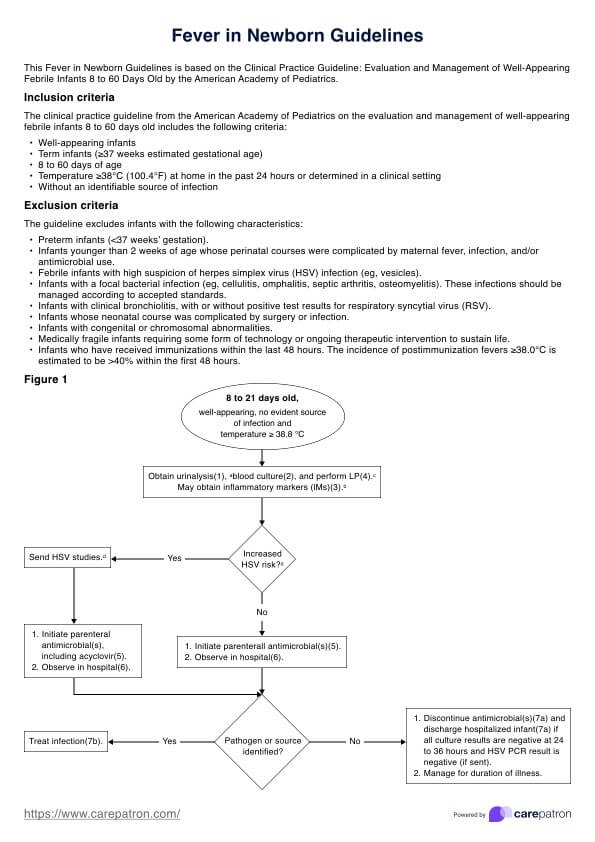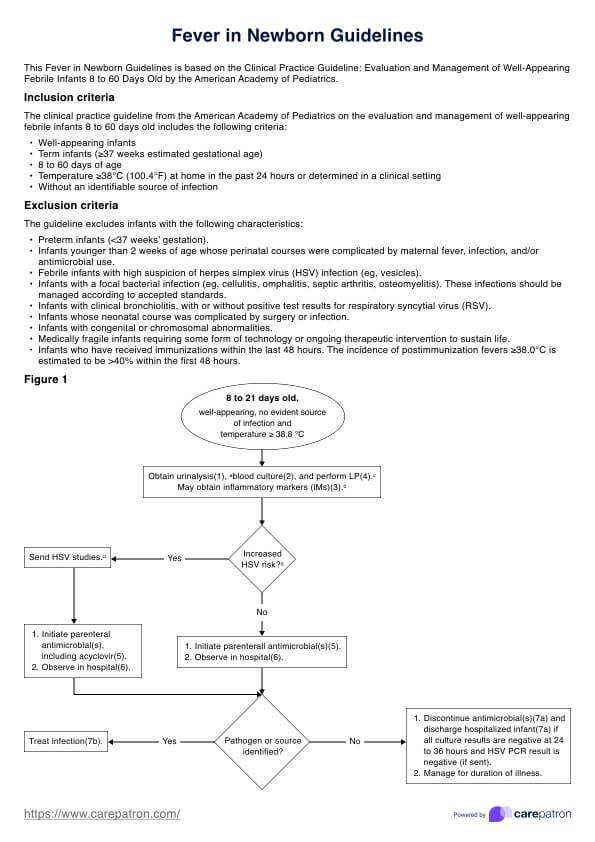Fever in Newborn Guidelines
Get our Fever in Newborn Guidelines Handout. Learn about fever thresholds, causes, and when to seek medical attention. Download our free template for healthcare professionals.


What's considered a fever in babies?
A fever in babies is typically defined as a body temperature of 100.4°F (38°C) or higher. The exact threshold can vary slightly depending on the method used to measure the temperature, which is essential for an appropriate evaluation:
- Rectal, ear, or temporal artery (forehead) thermometer: 100.4°F (38°C) or higher.
- Oral thermometer: 100°F (37.8°C) or higher.
- Axillary (armpit) thermometer: 99°F (37.2°C) or higher.
Causes of fever in babies
Fever in babies can be caused by a variety of factors, including:
- Infections: Most commonly, fever is a sign of an infection, such as a cold, flu, ear infection, invasive bacterial infection, or urinary tract infection.
- Immunizations: Some babies develop a low-grade fever after vaccinations.
- Overheating: Dressing the baby too warmly or being in a hot environment can cause an elevated temperature.
Complications of fever in babies
While most fevers are harmless and a natural response to infection, they can sometimes lead to complications, such as:
- Dehydration: Babies can lose fluids quickly with a fever, leading to dehydration or serious bacterial infections.
- Febrile seizures: Some babies and young children may experience seizures triggered by fever, known as febrile seizures.
- Serious infections: In rare cases, a fever can signify a more serious infection, such as meningitis or sepsis.
When to seek medical attention
It's important to seek medical advice if:
- The baby is younger than 3 months and has a fever of 100.4°F (38°C) or higher.
- The fever persists for more than a few days.
- The baby appears unusually irritable, lethargic, or unresponsive.
- Additional symptoms include rash, difficulty breathing, or persistent vomiting.
- If there are signs of serious bacterial infection.
Fever in Newborn Guidelines Template
Fever in Newborn Guidelines Example
Newborn Fever Guidelines
Our fever in newborn guidelines handout equips healthcare professionals with a succinct, accessible guide to managing febrile conditions in newborns. Based on the latest clinical practice guidelines, this handout provides clear algorithms for evaluating and managing well-appearing febrile infants aged 8 to 60 days of age.
Infants aged 8 to 21 days
For infants aged 8 to 21 days, the handout outlines the process for obtaining urinalysis, blood culture, lumbar puncture (LP), and blood testing for appropriate evaluation and determining the need for antiviral and antimicrobial treatments. If there is an increased risk of HSV (herpes simplex virus), HSV studies should be sent, and parenteral antimicrobials, including acyclovir, should be initiated. All infants in this age group should be observed in the hospital. If a pathogen or source of infection is identified, appropriate treatment should be administered. If not, antimicrobials should be discontinued after 24 to 36 hours if all culture results are negative.
Infants aged 22 to 28 days
The guidelines include obtaining urinalysis, blood culture, and inflammatory markers (IMs) for infants aged 22 to 28 days. Based on the results, further steps, such as performing an LP or administering parenteral antimicrobials, are decided. If abnormal IMs or positive urine culture results are found, appropriate treatment is initiated, and the infant is observed either in the hospital or at home, depending on the severity.
Infants aged 29 to 60 days
The guidelines recommend obtaining urinalysis, blood culture, and IMs for infants aged 29 to 60 days. The need for LP is determined by the presence of increased IMs or positive urinalysis results. Depending on the findings, parenteral or oral antimicrobials may be administered, and observation can occur either in the hospital or at home. Treatment is tailored based on whether a pathogen or source of bacterial infection is identified.
How to use our Fever in Infants Guidelines handout template
Our template is designed to help healthcare professionals manage febrile conditions in newborns efficiently. This is especially useful for managing cases in the emergency department. Here’s how to use it:
Step 1: Download a copy
Download a copy of our Fever in Newborn Guidelines handout template to get started. Simply scroll down until you see the 'Download' button.
Step 2: Review the contents of the handout
The handout includes clear algorithms for evaluating and managing febrile infants aged 8 to 60 days. It provides detailed steps in evaluating and managing febrile infants, along with inclusion and exclusion criteria.
Step 3: Educate your team
Distribute the handout to all relevant healthcare providers in your practice. Make sure everyone understands the steps and protocols outlined in the guidelines. Use team meetings or training sessions to address any questions or concerns.
Step 4: Implement the guidelines
Incorporate the guidelines into your daily practice. Refer to the handout when evaluating and managing febrile infants to ensure consistent and evidence-based care.
Benefits of using this handout
Our Fever in Newborn Guidelines handout equips healthcare professionals with a succinct, accessible guide to managing febrile conditions in newborns. This handout provides clear algorithms for evaluating and managing well-appearing febrile infants aged 8 to 60 days based on evidence.
This detailed yet easy-to-follow handout ensures that healthcare providers can quickly reference the appropriate steps to take when managing febrile infants, thereby enhancing the accuracy and efficiency of patient care. By following these evidence-based guidelines, providers can improve health outcomes for newborns with fever who are at low risk and ensure they receive timely and appropriate treatment.
Commonly asked questions
A fever in a newborn is typically defined as a body temperature of 100.4°F (38°C) or higher when measured rectally.
You should seek medical attention immediately if your premature infant is younger than 3 months and has a fever of 100.4°F (38°C) or higher or if they show signs of distress such as lethargy, difficulty breathing, or persistent crying.
Common causes of fever in newborns and young infants include infections (such as colds, flu, or urinary tract infections), reactions to immunizations, and overheating due to excessive clothing or environmental heat.







































































































